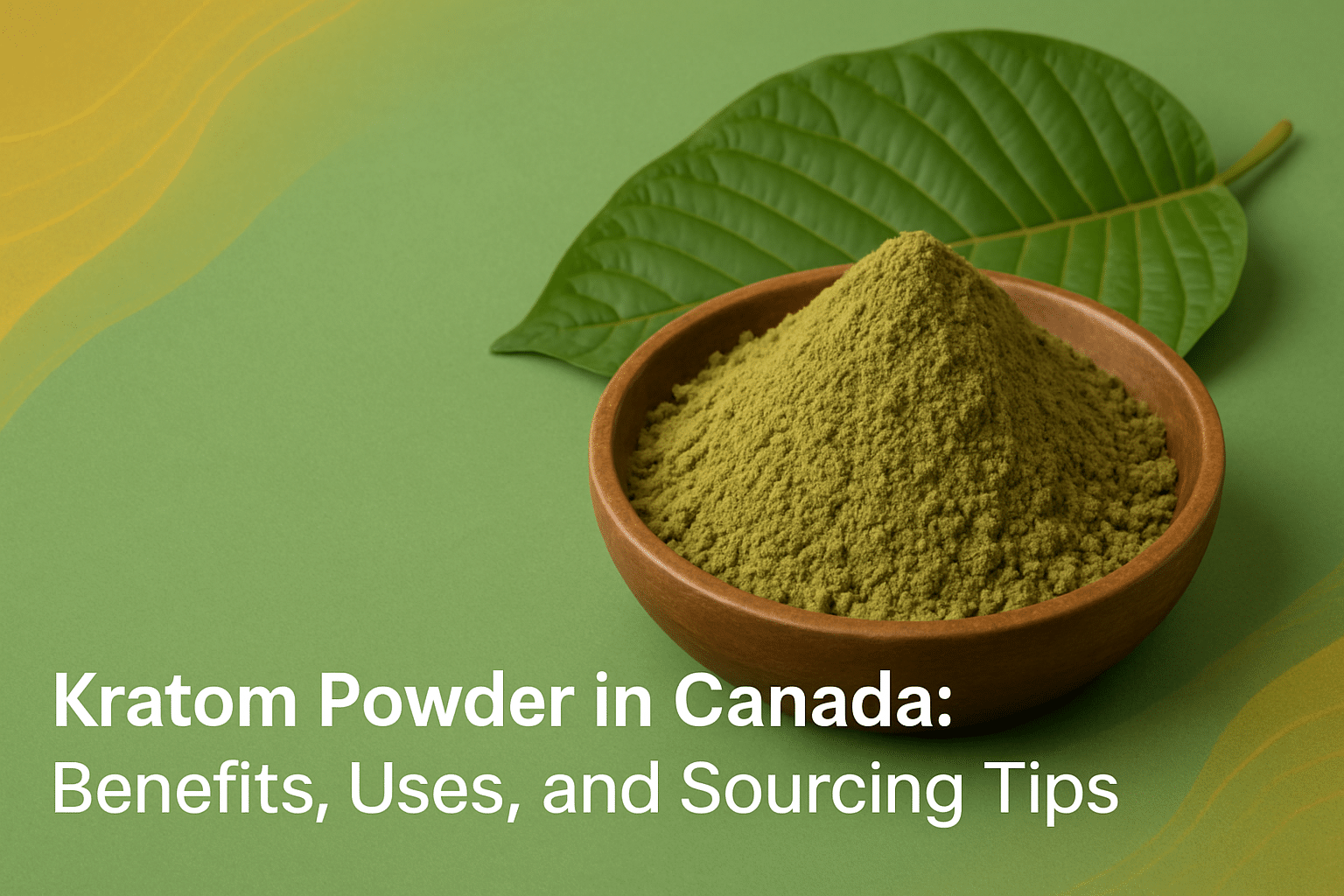Kratom has gained significant popularity among Canadians seeking natural botanical alternatives, yet many newcomers find themselves uncertain about proper preparation and usage methods. Understanding how to use kratom effectively requires knowledge of dosage, preparation techniques, and safety considerations that can make the difference between a positive and disappointing experience.
Learning how to use kratom properly involves much more than simply consuming the powder. The method of preparation, timing, dosage, and strain selection all play crucial roles in determining your overall experience. Whether you’re interested in kratom for research purposes or botanical exploration, this comprehensive guide will walk you through everything you need to know about responsible kratom usage.
From traditional preparation methods to modern convenience options, there are numerous ways to incorporate kratom into your routine. Each method offers unique advantages and considerations that can help you find the approach that works best for your specific needs and preferences.
Different Ways to Use Kratom Powder and Leaves
Traditional Toss and Wash Method
The toss and wash method remains one of the most popular approaches for how to use kratom powder effectively. In a 2021 US survey, 48% of kratom users reported using the toss and wash method for quick administration, making it the preferred choice for many experienced users.
This kratom toss wash method involves placing your measured dose directly on your tongue, followed immediately by water or juice to wash it down. The key to success with this technique lies in preparation and timing. Start by having your liquid ready before placing the powder in your mouth, as kratom powder can be quite dry and chalky.
Step-by-step toss and wash process:
-
Measure your desired dose accurately
-
Take a sip of liquid and hold it in your mouth
-
Tilt your head back slightly and place the powder on your tongue
-
Quickly swallow the mixture without breathing through your nose
-
Follow with additional liquid to ensure complete consumption
Mixing Kratom with Food and Beverages
Many users prefer mixing kratom with food and beverages to mask the naturally bitter taste. This approach makes the consumption experience more pleasant while potentially reducing stomach irritation. The best way take kratom powder through food mixing involves choosing complementary flavors that can overpower kratom’s earthiness.
Popular food and beverage options include yogurt, applesauce, chocolate milk, and citrus juices. Orange juice works particularly well because the acidity may help with absorption while the strong citrus flavor masks kratom’s taste. When mixing with food, ensure complete integration to avoid unexpected bitter pockets.
Effective mixing options:
-
Citrus juices (orange, grapefruit, lemon)
-
Chocolate or vanilla protein shakes
-
Yogurt with honey
-
Applesauce or pudding
-
Hot chocolate or coffee
Kratom Tea Preparation Techniques
Traditional tea preparation represents one of the most time-honored methods for how to use kratom. A 2019 study in Southeast Asia noted that 62% of traditional users prepare kratom as tea for daily consumption, highlighting this method’s cultural significance and effectiveness.
To make kratom tea recipe properly, you’ll need to simmer the powder gently rather than using boiling water, which can destroy beneficial alkaloids. The optimal temperature range falls between 160-180°F (70-80°C). Adding lemon juice or other acidic components during brewing may help extract alkaloids more effectively.
Basic kratom tea preparation:
-
Heat water to just below boiling
-
Add your measured kratom dose to the hot water
-
Simmer gently for 15-20 minutes
-
Strain the liquid to remove plant matter
-
Add honey, lemon, or other flavorings as desired
Kratom Dosage Guidelines and Safety Considerations
Starting Doses for New Users
Understanding proper kratom dosage for beginners is essential for a safe and positive experience. According to a 2020 US analysis, starting doses of 1-2 grams are recommended for new users to minimize adverse effects. This conservative approach allows you to gauge your body’s response before gradually adjusting.
New users should always start with the lowest possible dose and wait at least 45-60 minutes before considering any adjustments. Individual sensitivity varies significantly, and what works for one person may be too much or too little for another. Keep detailed notes about your experiences to help you find your optimal range.
Beginner dosage progression:
-
Week 1: Start with 1-1.5 grams
-
Week 2: Increase to 1.5-2 grams if needed
-
Week 3+: Adjust gradually in 0.5-gram increments
-
Maximum beginner dose: 3 grams
Factors Affecting Kratom Potency
Multiple variables influence how kratom affects individuals, making standardized dosing challenging. A 2018 Indonesian report found that alkaloid content in kratom varies by 20-30% based on harvest region and processing. This significant variation explains why the same dose from different batches might produce different effects.
Your body weight, metabolism, tolerance level, and recent food intake all play roles in determining kratom’s effects. Taking kratom on an empty stomach typically produces stronger effects, while consuming it after a meal may reduce intensity but extend duration. Understanding these factors affecting kratom potency helps you make informed decisions about timing and dosage.
Key potency factors:
-
Individual metabolism and body chemistry
-
Time since last meal
-
Tolerance level and usage frequency
-
Strain alkaloid profile
-
Storage conditions and product age
Timing and Frequency Recommendations
Responsible kratom usage frequency advice emphasizes moderation and mindful consumption patterns. Most experienced users recommend limiting usage to no more than twice daily, with many preferring once daily or less frequent consumption. Establishing clear usage guidelines helps maintain effectiveness while minimizing the risk of developing tolerance.
The timing of your kratom consumption can significantly impact your experience. Morning doses typically provide energy and focus benefits, while evening consumption may promote relaxation and better sleep. Allow at least 6-8 hours between doses to avoid overlapping effects and give your body time to process the alkaloids.
Popular Kratom Recipes and Preparation Methods
Kratom Smoothie and Juice Blends
Creating kratom smoothie blend ideas offers an excellent way to mask kratom’s natural taste while adding nutritional value to your routine. Fruit-based smoothies work particularly well because their natural sugars and strong flavors complement kratom’s earthy profile. The key lies in choosing ingredients that enhance rather than conflict with kratom’s characteristics.
Popular smoothie combinations include tropical fruits like mango and pineapple, which provide natural sweetness and help with taste masking. Adding banana creates a creamy texture that coats the kratom particles, making consumption more pleasant. Including citrus elements may also support alkaloid absorption.
Effective smoothie ingredients:
-
Banana for creaminess and natural sweetness
-
Pineapple or mango for tropical flavor masking
-
Orange juice for vitamin C and acidity
-
Honey or maple syrup for additional sweetness
-
Ice to improve texture and temperature
Kratom Capsule Preparation
Learning kratom capsule preparation steps provides a convenient alternative for those seeking precise dosing without taste concerns. In a 2022 Canadian health report, encapsulated forms account for 35% of botanical product usage for controlled dosing, demonstrating their popularity for consistent consumption.
Preparing your own capsules allows complete control over dosage and quality while eliminating taste issues. Use size “00” vegetarian capsules, which typically hold 0.5-0.7 grams of kratom powder. A capsule filling machine can speed up the process significantly if you plan to prepare multiple doses at once.
Capsule preparation essentials:
-
Size “00” vegetarian capsules
-
Accurate digital scale
-
Capsule filling machine (optional)
-
Clean workspace
-
Proper storage containers
Traditional Kratom Tea Recipes
Traditional kratom tea recipes have been refined over generations in Southeast Asia, offering time-tested methods for optimal extraction and palatability. These recipes often incorporate complementary herbs and spices that enhance both flavor and potential benefits. Understanding traditional approaches provides insight into how to use kratom most effectively.
A classic preparation involves simmering kratom with ginger and honey, creating a warming beverage that’s both flavorful and soothing. Adding cinnamon can provide additional warmth and sweetness, while lemon grass contributes a fresh, citrusy note that balances kratom’s earthiness.
Kratom Strain Selection and Usage Tips
Choosing the Right Strain for Your Purpose
Understanding how to choose kratom vein color and strain characteristics is fundamental to achieving your desired experience. Different kratom strains and their unique alkaloid profiles produce varying effects, making strain selection crucial for optimal results. The three main vein colors – red, green, and white – each offer distinct characteristics.
Red vein strains typically provide relaxing and calming effects, making them popular choices for evening use. Green vein varieties offer balanced effects that combine mild energy with relaxation. White vein strains generally provide more stimulating effects, making them suitable for morning or daytime use.
Understanding Vein Colors and Effects
The kratom strains effects guide begins with understanding vein color differences and their associated characteristics. A 2017 Malaysian study indicated that red vein kratom contains 15-25% higher mitragynine levels compared to green veins, explaining the distinct effect profiles between different vein colors.
Each vein color undergoes different processing methods that affect the final alkaloid content and resulting effects. Red vein processing involves extended fermentation, which increases certain alkaloid concentrations. White vein processing focuses on preserving the plant’s natural alkaloid balance, while green vein represents a middle ground between the two.
Vein color characteristics:
-
Red: Higher mitragynine content, relaxing effects
-
Green: Balanced alkaloid profile, moderate effects
-
White: Stimulating alkaloids, energizing effects
Storage and Freshness Maintenance
Proper safe kratom storage tips are essential for maintaining alkaloid potency and preventing degradation. According to a 2023 FDA analysis, proper storage prevents up to 40% degradation of kratom alkaloids over six months, making storage practices crucial for maintaining product quality.
Store kratom in airtight containers away from light, heat, and moisture. Glass jars with tight-fitting lids work excellently, as do vacuum-sealed bags. Avoid plastic containers for long-term storage, as they may allow moisture penetration. Label containers with strain names and dates to track freshness and rotation.
Storage best practices:
-
Use airtight glass containers
-
Store in cool, dark locations
-
Avoid exposure to humidity
-
Label with dates and strain information
-
Rotate stock using oldest products first
Best Practices for Responsible Kratom Use
Quality Testing and Lab Verification
Responsible kratom usage begins with selecting products that undergo comprehensive quality testing and lab verification. Reputable suppliers provide detailed lab reports showing alkaloid content, heavy metal levels, and microbial testing results. These reports ensure you’re receiving safe, pure products that meet quality standards.
Look for suppliers who test every batch for contaminants and provide certificates of analysis. This documentation should include testing for heavy metals like lead and mercury, microbial contaminants such as E. coli and salmonella, and alkaloid profiles that confirm strain authenticity.
Avoiding Common Usage Mistakes
Many newcomers make preventable mistakes when learning how to use kratom effectively. Taking too much too soon ranks among the most common errors, often leading to unpleasant experiences that could be easily avoided. Starting slowly and increasing gradually allows your body to adjust while helping you find your optimal dose range.
Another frequent mistake involves inconsistent timing and preparation methods. Switching between different consumption methods or timing patterns makes it difficult to establish consistent experiences. Choose one primary method and stick with it for several weeks before experimenting with alternatives.
Common mistakes to avoid:
-
Starting with doses that are too high
-
Mixing different strains without understanding interactions
-
Inconsistent timing and preparation methods
-
Ignoring individual tolerance changes
-
Neglecting proper storage practices
Monitoring Your Experience and Adjusting Accordingly
Learning to monitor kratom experience safely involves keeping detailed records of your usage patterns, effects, and any changes in tolerance or sensitivity. A 2021 peer-reviewed survey in the US showed that 70% of users adjust doses based on self-monitoring to optimize effects, demonstrating the importance of tracking your experiences.
Create a simple log that includes date, time, strain, dose, preparation method, and effects experienced. Note any changes in sleep, appetite, mood, or energy levels. This information helps you identify patterns and make informed adjustments to optimize your kratom usage.
|
Preparation Method |
Onset Time |
Duration |
Intensity |
Best For |
|---|---|---|---|---|
|
Toss and Wash |
15-30 minutes |
3-5 hours |
High |
Quick effects |
|
Tea |
20-40 minutes |
2-4 hours |
Moderate |
Gentle experience |
|
Smoothies |
30-45 minutes |
3-6 hours |
Moderate |
Taste masking |
|
Capsules |
45-60 minutes |
4-6 hours |
Consistent |
Precise dosing |
Understanding how to use kratom effectively requires patience, knowledge, and respect for this traditional botanical. By starting with conservative doses, choosing quality products, and maintaining detailed usage records, you can explore kratom’s potential while prioritizing safety and responsibility. Remember that individual responses vary significantly, making personal experimentation and adjustment essential for finding your optimal approach.
The key to successful kratom usage lies in education, quality sourcing, and responsible practices. Whether you choose traditional tea preparation, modern convenience methods, or anything in between, consistency and mindfulness will serve you well on your kratom journey.
Looking for premium, lab-tested kratom products to begin your journey safely? Explore 365 Kratom Canada’s carefully crafted blends, including energizing Sunrise, focusing Clarity, and relaxing Goodnight formulations – all comprehensively tested for purity and potency to support your botanical research needs.



